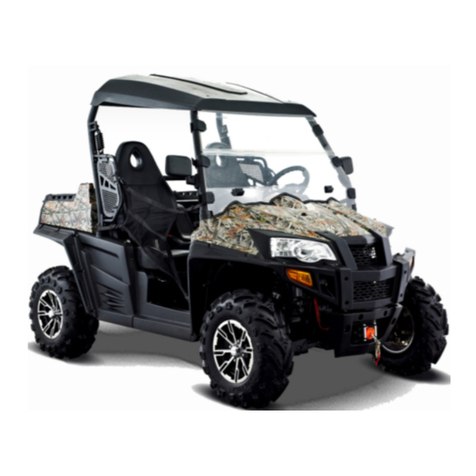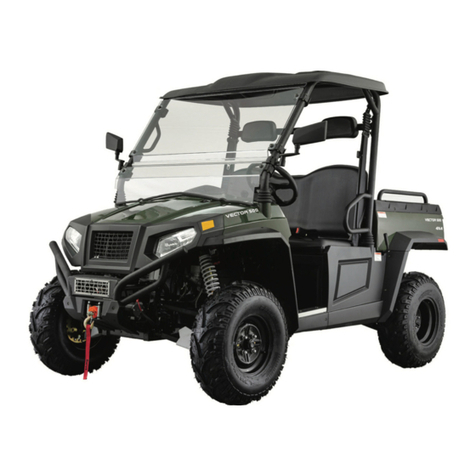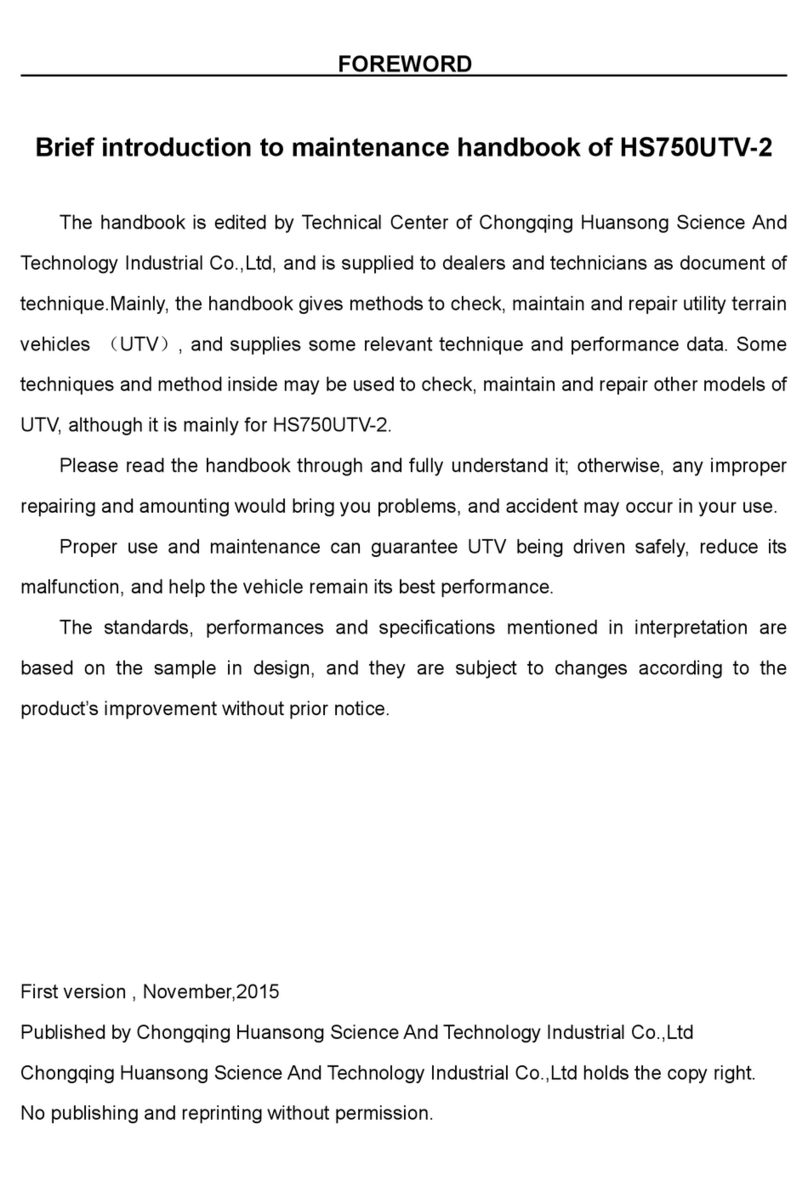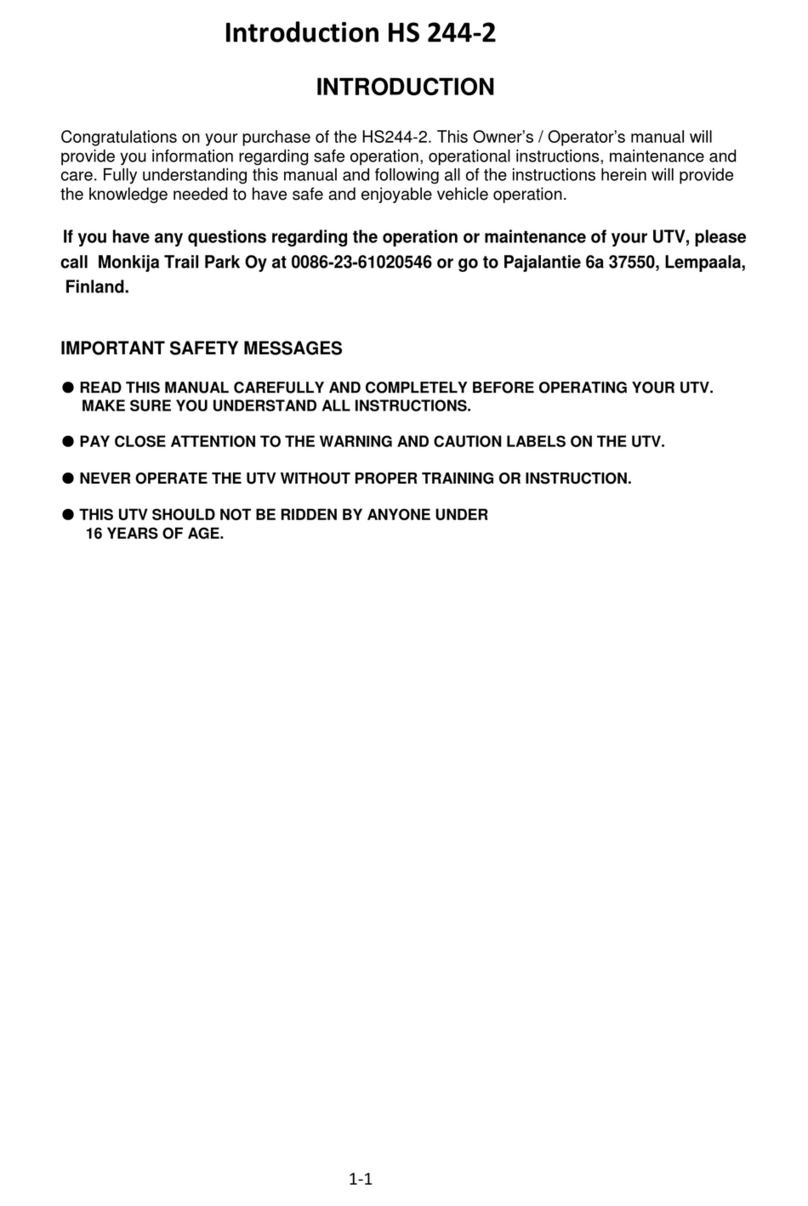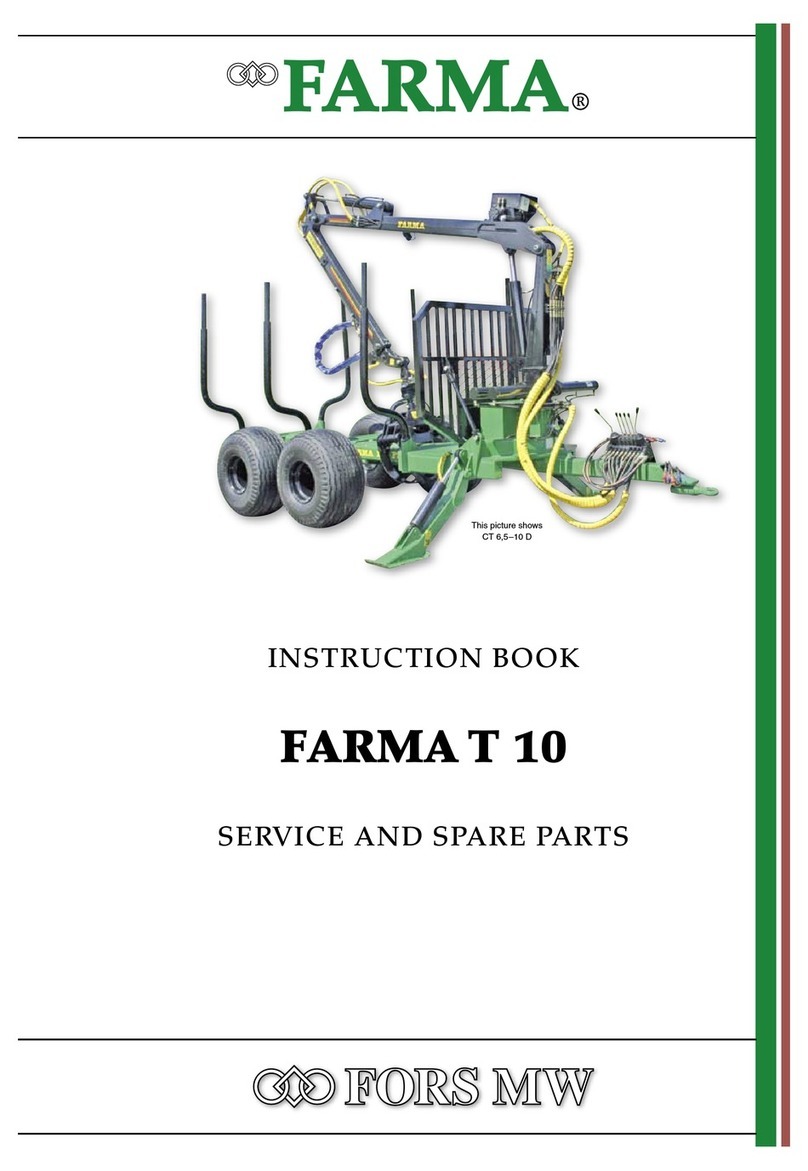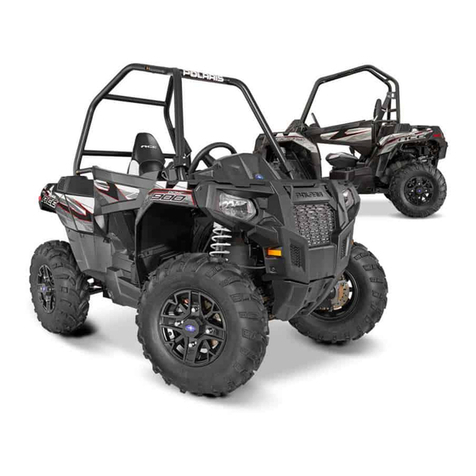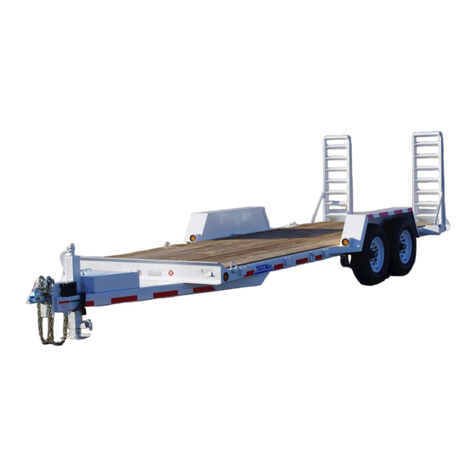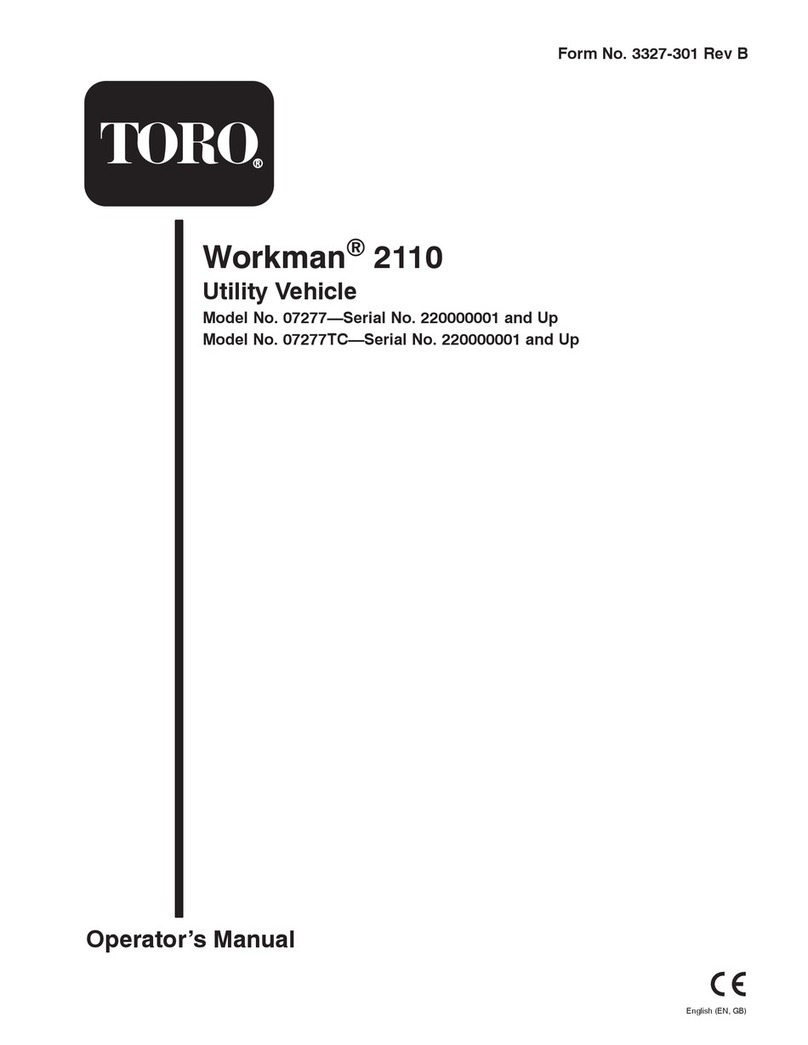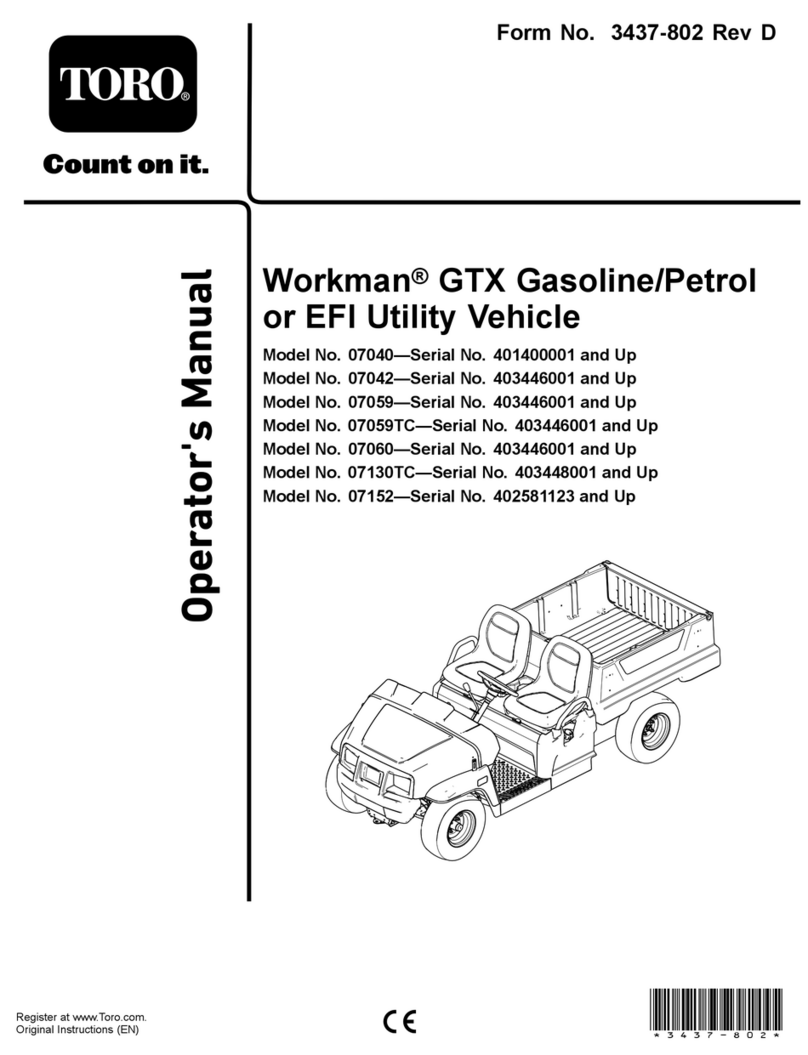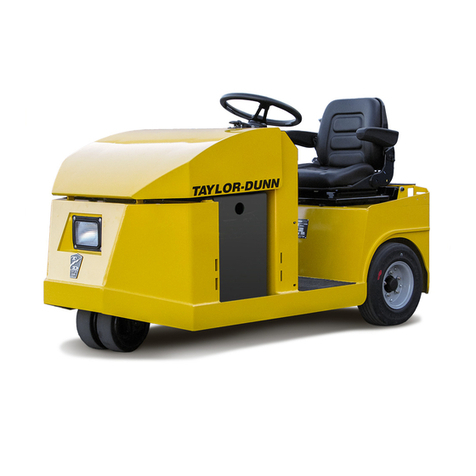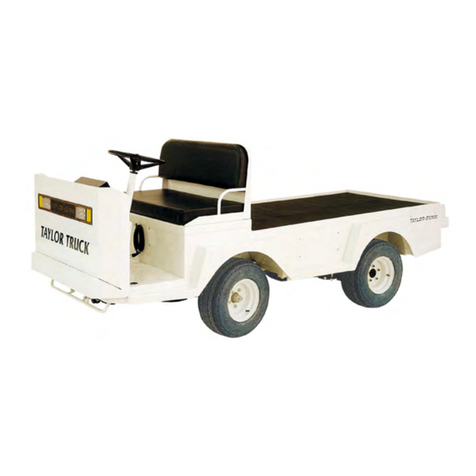Hisun Motors MX 550 User manual

Safe Operation Practices • Set-up • Operation • Product care • Specications
OperatOr’sManual
Utility Vehicle
MX 550/750
NOTE: This Operator’s Manual covers several models. Features may vary by model. Not all features in this manual are
applicable to all models and the model depicted may differ from yours.
WARNING
Read and follow all safety rules and instructions in this manual before attempting to operate this vehicle.
Failure to comply with these instructions may result in personal injury - SAVE THESE INSTRUCTIONS.
WARNING
CALIFORNIA PROPOSITION 65
Engine Exhaust, some of its constituents, and certain vehicle components contain or emit chemicals known to the State of
California to cause cancer and birth defects or other reproductive harm. www.p65warnings.ca.gov
Battery posts, terminals, and related accessories contain lead and lead compounds, chemicals known to the State of
California to cause cancer and reproductive harm. Wash hands after handling.
Record Product Information
Before setting up and operating your new utility vehicle
please locate the model plate and record the information
in the provided area to the right. You can locate the model
plate by looking on the frame above the left rear tire.
See the image below. This information will be necessary,
should you seek technical support via our web site,
Customer Support Department, or with a local authorized
service dealer.
Model Number
Serial Number
N0. CCD22550750
(January 13,2022)
Cub Cadet® is a registered trademark of Stanley Black & Decker, Inc., used
under license. Cub Cadet® es una marca registrada de Stanley Black & Decker,
Inc., utilizada bajo licencia.
© 2023 Cub Cadet U.S. & Canada Only
CubCadet.com

2
SAFE OPERATION PRACTICES
GENERAL OPERATION
1. Read, understand, and follow all instructions on the vehicle
and in the manual before attempting to operate or service
vehicle. Keep this manual in a safe place for future and
regular reference and for ordering replacement parts.
2. This is an off-highway utility vehicle and it should not be
operated on public highways. Know and comply with all laws
and regulations governing the use of off-highway vehicles
in your area.
3. This vehicle handles and maneuvers differently than a normal
passenger car. Sharp high speed turns and abrupt maneuvers
can cause vehicle to roll over or go out of control. Slow down
when turning and avoid abrupt maneuvers.
4. Handling and maneuvering characteristics of vehicle change
depending upon cargo load. Heavy loads affect steering,
braking, stability, and overall handling of vehicle.
5. Be familiar with all instructions and controls and their proper
operation before starting vehicle.
6. Never allow adults to operate this vehicle without
proper instruction.
7. Never allow children under 16 years old to operate this
vehicle. Children 16 years old and over should read and
understand the operation instructions and safety rules in this
manual and should be trained and supervised by a parent
unless driver has obtained a state-issued motor vehicle
driver’s licence.
8. Watch for traffic when operating near or crossing roadways.
This vehicle is not intended for use on any public roadway.
9. Do not operate this vehicle while under the influence of
alcohol or drugs.
10. Never carry more than one passenger. This vehicle is designed
to carry the driver and one passenger only. No riders are
allowed in cargo box or anywhere else on vehicle, except in
the driver and passenger seats.
11. Keep all body parts (i.e. head, arms, hands, legs, feet) inside
vehicle when vehicle is in motion.
12. Always remain seated and keep both hands on the steering
wheel when driving the vehicle.
13. Sit on the center of the seat and keep both feet within
the foot platform perimeter. Clean foot platform if dirty
and remove any debris from around foot controls, e.g.
brake pedal.
14. Do not misuse the vehicle. Reckless operation can lead to
accidents, severe bodily injury or death.
15. Inspect area around vehicle before moving, especially in
reverse. Back up slowly. Always look down and behind
before and while backing to avoid a back-over accident. Keep
bystanders out of area.
16. Avoid driving through water, since loss of control may occur.
Drive belt may slip if exposed to water thus reducing vehicle
pulling power and stopping vehicle entirely. Water depth
should not exceed 15” (38 cm).
17. Always use vehicle lights while operating in low
light situations.
18. Do not mount or leave vehicle while it is in motion or in
actual operation.
19. Avoid sudden starts, stops, or turns and always use a level
turn-around area.
20. Never leave vehicle unattended with the engine running.
Move the shift lever to “PARK” position, turn ignition key to
the “OFF” position and remove the key.
21. Check overhead clearances carefully before driving under low
hanging tree branches, wires, power lines, bridges, before
entering or leaving buildings, or in any other situation where
the operator and/or occupant protection structure (OPS) may
be struck, which could result in serious injury.
22. Always use the occupant protection structure (OPS) and
seat belt for safe operation. Overturning the utility vehicle
without an OPS, or with an OPS and the seat belt unfastened,
can result in death or injury.
23. Always use the seat belt and never remove the occupant
protection structure (OPS) or operate the vehicle without
the OPS.
WARNING
This symbol points out important safety instructions which, if not followed, could endanger the personal
safety and/or property of yourself and others. Read and follow all instructions in this manual before
attempting to operate this vehicle. Failure to comply with these instructions may result in personal injury.
When you see this symbol. HEED ITS WARNING!
DANGER
This vehicle was built to be operated according to the safe operation practices in this manual. As with any type of off-
highway utility vehicle, carelessness or error on the part of the operator can result in serious injury. Failure to observe the
following safety instructions could result in serious injury or death.
FAILURE TO FOLLOW THE WARNINGS CONTAINED IN THIS MANUAL CAN RESULT IN SERIOUS INJURY OR DEATH.

3
SAFE OPERATION PRACTICES
Towing
1. Always use an approved hitch and hitch point provided on the
utility vehicle.
2. Do not tow more than 1200 lbs (544 kg) rolling weight (i.e.
trailer plus cargo).
3. Never load more than 110 lbs (50 kg) tongue weight on tow
bracket provided.
4. Go slow and use extra care when towing a trailer. Allow for
increased braking distance. Load trailer properly.
5. Do not tow heavy loads on slopes greater than 5° incline.
When going downhill or turning, the extra weight tends to
push the tow vehicle and may cause you to lose control (i.e.
braking and steering ability are reduced, towed equipment
may jack-knife and cause utility vehicle to overturn).
Occupant size and capacity
1. Make sure operators are at least 16 years old and have a valid
driver’s license.
2. Each occupant should be able to sit with their back against
the seat, feet flat on the floor, and hands on the steering
wheel or handholds.
3. The operator should be tall enough to wear the seat belt
properly and reach all controls.
4. Passengers should also be tall enough for the seat belt to
fit properly and be able to brace themselves, as necessary,
by placing both feet firmly on the floor while gripping the
handholds. Keep all body parts completely inside the vehicle.
24. The doors are designed to assist in keeping the operator
and passenger inside the vehicle during operation. Do NOT
operate vehicle without doors in place.
25. Improper use of the vehicle or failure to properly maintain
it could result in decreased vehicle performance or
personal injury.
26. Engine must be stopped when cleaning, servicing, adjusting,
repairing, or installing attachments on utility vehicle.
27. After striking foreign objects, stop the vehicle, and shut off
the engine. Inspect for damage and repair the damage before
restarting and operating.
28. Do not start or operate vehicle in an inside area, unless it
is adequately ventilated. Engine exhaust contains carbon
monoxide fumes, which are very poisonous and can
be deadly.
29. Assure safety interlock switch is adjusted correctly so engine
cannot be started unless gearshift is in the “PARK” position
with the brake pedal depressed.
30. Do not touch engine or exhaust components while engine is
running or soon after it is stopped. They will be hot and can
cause a burn.
31. Always inspect your vehicle each time you use it to make sure
it is in safe operating condition. Always follow the inspection
and maintenance procedures and schedules described in
this manual.
32. Do not use the differential lock when driving down hill. Do
not use the differential lock at speeds over 25 mph. Allow for
greater turning radius and more difficult steering when the
differential lock is engaged.
33. If situations occur which are not covered in this manual, use
care and good judgement. Contact your local service center
or call toll free 1-877-282-8684 for the name of your nearest
service center.
Dress Properly
1. Proper clothing can reduce the severity of injury in the event
of an accident.
2. Always wear appropriate eye protection and protective
clothing. It is also recommended that you wear a properly
fitting D.O.T. approved helmet.
Slope Operation
Slopes are a major factor related to loss of control and rollover
accidents, which can result in severe injury or death. If a slope
is steeper than a 15° incline, do not operate this vehicle on that
area. Exercise extreme caution while operating on slopes.
DO:
1. Travel straight up and down slopes, not across. Exercise
extreme caution when changing direction on slopes.
2. Travel slowly while on a slope. Always keep the forward
speed limited when going down slopes to take advantage of
the engine braking action.
3. Keep all movement on the slopes slow and gradual. Avoid
starting or stopping on a slope.
4. Avoid slopes with slippery, loose, or bumpy surfaces as they
are especially hazardous.
5. Use extra care while carrying cargo. It may affect the stability
of the vehicle. Spread the load evenly and tie down.
DO NOT:
1. Do not travel near drop-offs, ditches, or embankments. The
vehicle could suddenly turn over if a wheel is over the edge of
a cliff, ditch, or if an edge caves in.
2. Do not stop or start suddenly when going uphill or downhill.
Be especially cautious when changing direction on slopes.
3. Do not turn sideways to the hill. The vehicle may roll over. If
you must turn, go slow and do so carefully and gradually.
4. Do not carry cargo or tow loads on steep slopes.

4
SAFE OPERATION PRACTICES
SAFETY FRAME OPS
1. Your vehicle is equipped with an occupant protection
structure (OPS) which must be maintained in a fully
functional condition. Use care when driving through
doorways or spaces with a low overhead.
a. Never modify the OPS in any way.
b. Never attempt to straighten or reweld any part of
the main frame or retaining brackets that have been
damaged. Doing so may weaken the structure and
endanger your safety.
c. Never secure any parts other than manufacturer approved
accessories on the main frame or attach the safety frame
with anything other than the special fasteners specified.
d. Never attach ropes, chains, or cables to the OPS for
pulling purposes.
Cargo Box Loading/Operation
1. Do not exceed vehicle’s Total Load Capacity rating of 1000
lbs (453.5 kg). This includes operator, passenger, accessories,
and cargo.
2. Do not exceed 500 lbs (226.7 kg) load in cargo box.
3. Spread load evenly and secure to prevent movement.
4. Do not load above height of cargo box front panel. Load could
shift forward and injure driver or passenger.
5. Avoid loads which exceed the physical dimensions of
cargo box.
6. Go slow. Heavy loads will affect steering, braking, stability,
and overall handling of the vehicle. Limit loads to those that
can be safely controlled.
7. Avoid sudden starts, stops, and turns which could cause load
to shift.
Cargo Box Lift
1. Stop vehicle on level ground, move the shift lever into the
“PARK” position before raising cargo box.
2. On manual lift units, unload cargo box before raising
cargo box.
3. Do not operate vehicle with cargo box in raised position.
4. Do not operate vehicle with cargo box latch unlatched.
Always re-latch upon manually lowering cargo box.
WHEN USING OPTIONAL ELECTRIC LIFT:
a. Stay in driver’s seat.
b. Keep body parts away from cargo box and keep all
bystanders away.
c. Do not allow rear wheels to hang over the edge of a drop-
off when raising cargo box. The load in the cargo box may
shift causing the vehicle to tip over backwards.
e. Although the OPS, when used with a properly secured
seat belt, provides a crush-protective environment
in the event of a tip-over or rollover, never take
unnecessary risks.
CHILDREN
1. Tragic accidents can occur if the operator is not alert to the
presence of children. Children are often attracted to the
vehicle. They do not understand the dangers. Never assume
that children will remain where you last saw them. Avoid run
over accidents.
a. Keep children out of the immediate area of the vehicle
and in watchful care of a responsible adult other than
the operator.
b. Be alert and turn the vehicle off if a child enters the area.
c. Before and while backing, look behind and down for
small children.
d. Never carry small children, they may fall off and be
seriously injured or interfere with safe vehicle operation.
e. Use extreme care while approaching blind corners,
doorways, shrubs, trees, or other objects that may
block your vision of a child who may run into the path of
the vehicle.
f. Remove key when vehicle is unattended to prevent
unauthorized operation.
2. Never allow children under 16 years old to operate this
vehicle. Children 16 years old and over should read and
understand the operation instructions and safety rules in this
manual, should be trained and supervised by a parent and
have obtained a state-issued motor vehicle driver’s license.
3. Do not let children ride in the cargo box, in the driver’s or
passenger’s lap or anywhere other than the passenger seat.
Never give small children a ride; not even in the passenger
seat. They may fall off.
SERVICE
Safe Handling of Fuel:
1. To avoid personal injury or property damage use extreme
care in handling fuel. Fuel is extremely flammable and the
vapors are explosive. Serious personal injury can occur when
fuel is spilled on yourself or your clothes which can ignite.
Wash your skin and change clothes immediately.
a. Use only an approved fuel container.
b. Never carry or fill containers inside the vehicle’s bed or on
a truck or trailer. Always place containers on the ground
away from your vehicle before filling.
c. When practical, remove gas-powered vehicle from the
truck or trailer and refuel it on the ground. If this is not
possible, then refuel on a trailer with a portable container,
rather than from a fuel dispenser nozzle.

5
SAFE OPERATION PRACTICES
d. Keep the nozzle in contact with the rim of the fuel tank or
container opening at all times until fueling is complete.
Do not use a nozzle lock-open device.
e. Extinguish all cigarettes, cigars, pipes, and other sources
of ignition.
f. Never fuel indoors.
g. Never remove gas cap or add fuel while the engine is hot
or running. Allow engine to cool at least five minutes
before refueling.
h. Never over fill fuel tank. Fill tank to no more than one
inch below bottom of filler neck to allow space for fuel
expansion. Leave additional room for fuel expansion if the
utility vehicle will be in a high-altitude situation.
i. Replace fuel cap and tighten securely.
j. If fuel is spilled, wipe it off immediately. Move vehicle
to another area. Wait five minutes before starting
the engine.
k. To reduce fire hazards, keep engine compartment and
exhaust system free of grass, leaves, or other debris
build-up. Clean up oil or fuel spillage and remove any fuel
soaked debris.
l. Never store the vehicle or fuel container inside where
there is an open flame, spark or pilot light as on a water
heater, space heater, furnace, clothes dryer, or other
gas appliances.
General Service
1. Never run an engine indoors or in a poorly ventilated area.
Engine exhaust contains carbon monoxide, an odorless, and
deadly gas.
2. Before cleaning, repairing, or inspecting, make certain all
moving parts have stopped. Remove the key to prevent
unintended starting.
3. Check brake operation frequently as it is subjected to wear
during normal operation. Adjust and service as required.
4. The cooling system is under pressure, never remove the
radiator cap when the system is hot. Slowly turn the cap to
the first stop to release pressure before removing the cap.
5. Keep all nuts, bolts, and screws tight to be sure the vehicle is
in safe working condition.
6. Never tamper with the safety interlock system or other safety
devices. Check their proper operation regularly.
7. Never attempt to make adjustments or repairs to the vehicle
while the engine is running.
8. Wait for vehicle to cool before servicing exhaust or
coolant system.
9. Stop vehicle on level ground. Place shift lever in park
before servicing.
10. Maintain or replace safety and instruction labels,
as necessary.
11. Follow the vehicle maintenance and service schedules to
ensure that all mechanical and safety systems are working
properly and not worn excessively. Failure to do so can result
in accidents, injuries, or death.
12. Observe proper disposal laws and regulations for gas, oil, etc.
to protect the environment.
13. Prior to disposal, determine the proper method to dispose
of waste from your local Environmental Protection Agency.
Recycling centers are established to properly dispose of
materials in an environmentally safe fashion.
14. Use proper containers when draining fluids. Do not use
food or beverage containers that may mislead someone
into drinking from them. Properly dispose of the containers
immediately following the draining of fluids.
15. Do NOT pour oil or other fluids into the ground, down a
drain or into a stream, pond, lake, or other body of water.
Observe Environmental Protection Agency regulations when
disposing of oil, fuel, coolant, brake fluid, filters, batteries,
tires, and other harmful waste.
16. We do not recommend the use of a pressure washer to
clean your vehicle. They may cause damage to electrical
components; wheel spindles; pulleys; bearings; or the engine.
The use of high-pressure water will result in shortened life
and reduce serviceability.
NOTICE REGARDING EMISSIONS
Where applicable, this vehicle is certified to federal EPA and
California Air Resources Board (CARB) emissions standards
for Off-Highway Recreational Vehicles (OHRV). The Engine
Owner’s Manual is supplied by the engine manufacturer, and
provides additional information relating to the emission system,
warranty, and maintenance of the engine in accordance with EPA
and/or CARB regulations. Consult your engine manual for the fuel
requirements for your engine.
Gasoline powered products may be equipped with the following
emission control systems: Engine Modification (EM), Oxidizing
Catalyst (OC), Oxygen Sensor (O2S), Multi-port Fuel Injection
(MFI), Electronic Control Module (ECM), Secondary Air Injection
(SAI) and Three Way Catalyst (TWC). When required, models
are equipped with low permeation fuel lines and fuel tanks for
evaporative emission control. Please contact Customer Support
for information regarding the evaporative emission control
configuration for your model.
DO NOT MODIFY ENGINE
To avoid serious injury or death, do not modify engine in any
way. Tampering with engine can lead it to operate at unsafe
speeds. Never tamper with factory setting of the engine and
its components.
This manual suits for next models
1
Table of contents
Other Hisun Motors Utility Vehicle manuals
Popular Utility Vehicle manuals by other brands

Cushman
Cushman Turf Truckster 84069 Parts & maintenance manual
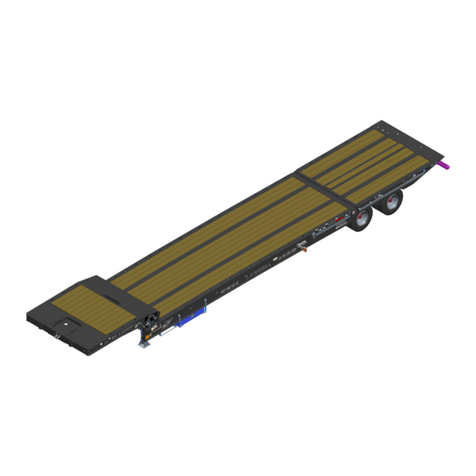
Landoll
Landoll 900D Series Operator's manual
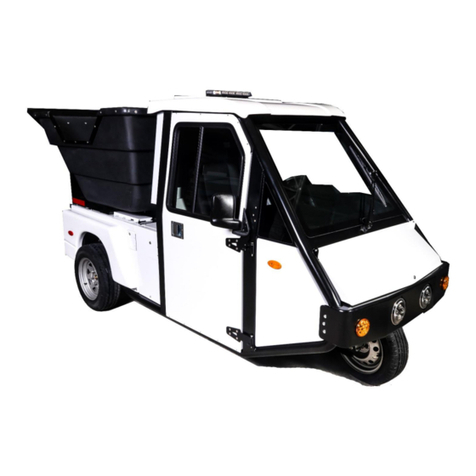
Westward
Westward Go-4 XTR Operator's manual
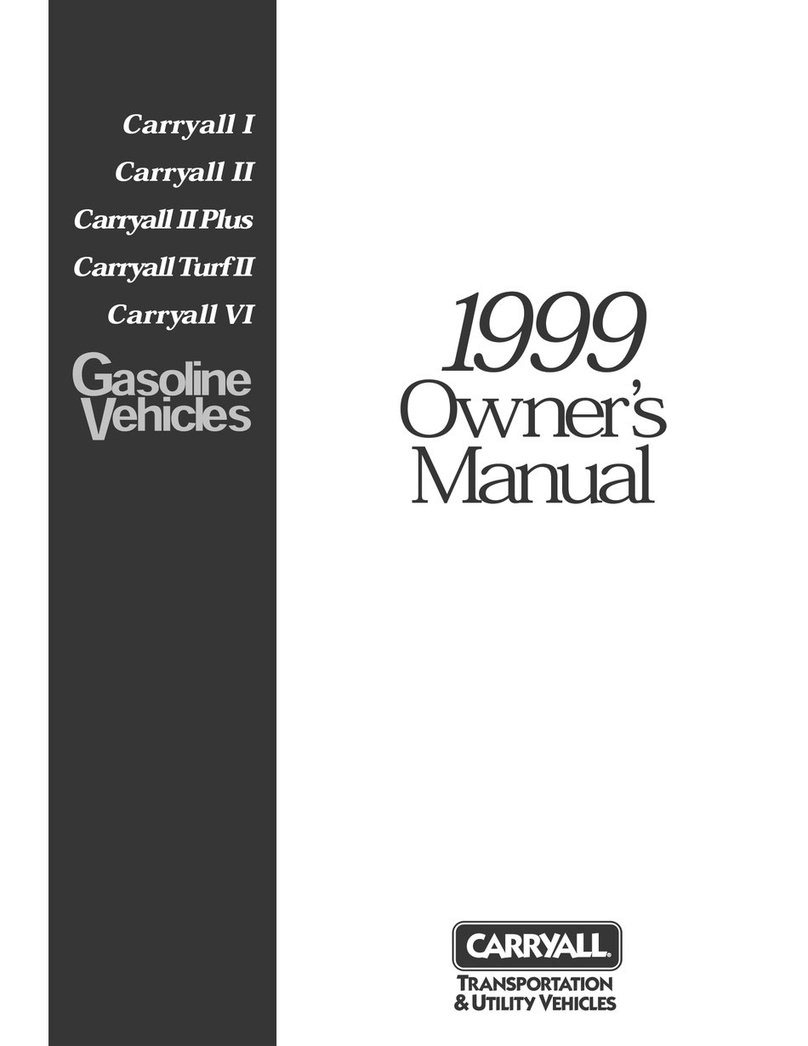
Club Car
Club Car Carryall I 1999 owner's manual

Etnyre
Etnyre Street Flusher operation, maintenance, parts and safety manual

Landoll
Landoll 340 Operator's manual
